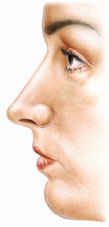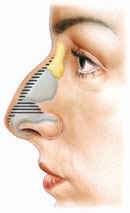Nose Job
 This is one of the most frequently requested types of cosmetic procedure. It is a surgical procedure which reshapes and realigns the nose either to repair injury or to correct a deformity which may be hereditary. This is the main anatomical objective but it must be remembered that the benefits may extend way beyond this in terms of enhanced self-image, greater pose and confidence and improved performance. It is appropriate for males or females after the age of puberty. The nose is a very important facial feature. Although this operation is anatomically straightforward, it requires the most meticulous of surgical skills, and the aesthetic anticipation and perception of an artist, in order to form a ‘new nose' that will blend in and harmonise with the This is one of the most frequently requested types of cosmetic procedure. It is a surgical procedure which reshapes and realigns the nose either to repair injury or to correct a deformity which may be hereditary. This is the main anatomical objective but it must be remembered that the benefits may extend way beyond this in terms of enhanced self-image, greater pose and confidence and improved performance. It is appropriate for males or females after the age of puberty. The nose is a very important facial feature. Although this operation is anatomically straightforward, it requires the most meticulous of surgical skills, and the aesthetic anticipation and perception of an artist, in order to form a ‘new nose' that will blend in and harmonise with the  whole face, and give natural and individual results. Through rhinoplasty many problems can be reduced or corrected - long noses can be shortened, crooked noses straightened, bumps and hooks removed, wide noses can be narrowed, bulbous tips removed, nostrils made smaller, etc. It is whole face, and give natural and individual results. Through rhinoplasty many problems can be reduced or corrected - long noses can be shortened, crooked noses straightened, bumps and hooks removed, wide noses can be narrowed, bulbous tips removed, nostrils made smaller, etc. It is  important to realise that drastic changes to the nose are not desirable, for various reasons. For instance, the underlying bone structure may not permit it, or the potential result may not harmonise with other facial features, and therefore, would look unnatural. The surgeon also has to ensure that any reshaping to the nose does not impair breathing function. A patient usually has an idea of the shape of nose desired, but this must be realistic and make allowances for the points mentioned and clearly the advice of the surgeon on these points must be followed. Results are limited by your anatomy and a nose matching someone else's features may not match your own. It must be remembered that although surgical changes to the nose should be subtle the overall facial transformation thus effected can be very significant indeed. important to realise that drastic changes to the nose are not desirable, for various reasons. For instance, the underlying bone structure may not permit it, or the potential result may not harmonise with other facial features, and therefore, would look unnatural. The surgeon also has to ensure that any reshaping to the nose does not impair breathing function. A patient usually has an idea of the shape of nose desired, but this must be realistic and make allowances for the points mentioned and clearly the advice of the surgeon on these points must be followed. Results are limited by your anatomy and a nose matching someone else's features may not match your own. It must be remembered that although surgical changes to the nose should be subtle the overall facial transformation thus effected can be very significant indeed.
  
There are risks associated with rhinoplasty, as with any surgery, but these are limited and complications rare. The greatest risk is that of a result undesirable to the patient. This should be reduced by an understanding between the patient and the surgeon reached at consultation. It is also possible for some asymmetry or contour irregularity to develop but this can usually be corrected later. Rhinoplasty involves the removal or alteration of nasal bone and cartilage. The skin subsequently adapts to the new bony arrangement of the nose. Surgery is usually performed internally, that is from inside of the nose, thus leaving no visible scarring, except under special circumstances. For instance, to alter nostril size, an incision may be required at the side creases of the nose where it meets the face, but these incisions normally heal very quickly and the scars become virtually invisible. The operation is performed under twilight or general anaesthesia. The procedure itself takes about an hour, or more, depending on its complexity. An overnight stay in the clinic is usually required. After the first twenty four hours post-operatively there is usually little discomfort but pain relievers and sedatives can be prescribed. After the operation a small splint will be applied to protect the nose, and maintain its position during the early stages of healing. Following surgery, swelling, tenderness and discolouration about the eyes and nose is normal, but this will subside during the following seven to fourteen days. It is very important obviously to avoid injury or distortion to the nose during the healing process and to follow the surgeon's instructions on aftercare very closely. The nose will be presentable after the plaster is removed (usually at one week) and make-up is then allowed. One can return to work after seven to ten days post-operatively. Full benefits of the surgery take some time to develop. I cannot over emphasize the importance of being patient in the post operative phase. Major changes are apparent immediately, but your nose will continue to change to a certain degree for up to 2-3 months. Expect this and accept this. It usually takes six to nine months for all the subtler contour changes to take place. This process can not be hurried and nature must be allowed to take its course. It is a lengthy process and patience and understanding are required.
|